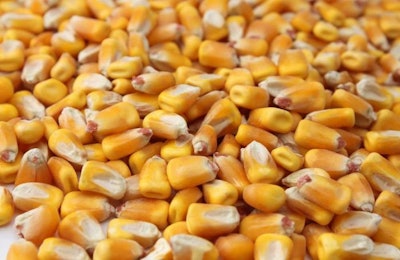
Corn ending stocks in China are forecast down by 2.0 million metric tons (mmt), according to the latest Feed Outlook report from the U.S. Department of Agriculture Economic Research Service (ERS), but with 111.5 mmt in store, the country holds more than half the world’s corn stocks.
Because China has created a degree of artificial scarcity by holding large inventories, global markets are nervous, according to Fred Gale of the USDA ERS, in an article in Nikkei Asian Review presenting his own views.
Gale writes that the country began subsidizing cultivation and stockpiling farm commodities, including rice, in order to achieve food security. However, global prices have since declined markedly and the stocks are deteriorating, yet officials fear havoc on the markets if they let the crops out.
In January, the government tried to auction off 10,000 metric tons (mt) of surplus stored wheat but, according to Gale, what little was sold went at a substantial discount because of its poor quality. There was also little interest among buyers for a consignment of U.S. wheat that had been in storage for more than 2 years because the new season’s wheat could be imported at a much lower price.
The country has a year’s supply of corn in storage after buying up large portions of the past four corn crops to prevent prices from falling. A significant portion is moldy and unsuitable for either food manufacturing or animal feed, Gale says.
“Now a crisis is bubbling as China’s stockpile of corn, the country’s largest crop, moves skyward and becomes a budget-buster,” writes Gale.
Market value down
He explains the stocks were financed with government loans that now well exceed the stock’s value. According to Gale, the book value of the cotton and corn stockpiles together likely exceeds US$100 billion, but the market value of the crops may be 60 cents on the dollar or even less. While current corn prices in China are down about 15 percent from the purchase prices of 2013-14, the government is buying another record amount of corn to keep prices from falling further.
Officials in China admit that they have a problem, Gale writes. A top rural policy official has said preventing corn stockpiles from getting even bigger is a priority for 2016, and a key government document says that corn prices should be allowed to fall to market values. In the absence of a similar policy for wheat and rice, officials plan to hold large stockpiles, and maintain control over import quotas.
China’s maintenance of wheat price supports while reducing corn prices is causing a shift from feeding wheat to using more corn, according to the ERS Feed Outlook.
In its latest Wheat Outlook, ERS points out that when the government modifies the level of support for one of the regulated commodities, it effectively changes relative prices for all of them. This inevitably leads to big shifts in production and consumption for all commodities, and Chinese government policy will likely help push ending wheat stocks up further into record territory.
China’s animal feed production exceeded 200 mmt in 2015.

















